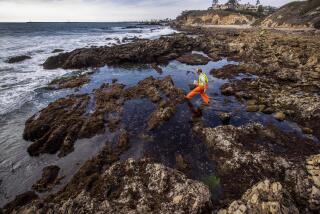Federal Damage Survey of Exxon Valdez Begins
- Share via
The National Transportation Safety Board on Monday began a thorough survey to determine the extent of damage done to the tanker Exxon Valdez when it ran aground March 24 in Alaska’s Prince William Sound.
The physical inspection marked the first time that investigators have set foot on the ship that ran aground on a reef. The NTSB has been relying on photographs taken by divers who surveyed the ship’s damaged hull from the outside.
But inspectors now will have the opportunity to step inside the Valdez and physically inspect its damaged hull, its holding tanks and a complex system of pipes and valves that load and unload oil.
The NTSB will be accompanied by representatives from the state of Alaska, Exxon and Alyeska Pipeline Service Co., the oil-company consortium that operates the trans-Alaskan pipeline. The investigation is being conducted at National Steel & Shipbuilding Co., where the crippled tanker is in dry dock.
“We’re going to, in a quantitative way, determine the extent of damage,” said Lou Colucciello, chief of the NTSB’s Washington, D.C.-based marine accident division. “It’s being done with the participation of parties and will take several days.”
A Lot of Measurements
Crews will “make measurements to determine how deep the penetrations were, how extensive the damage was,” Colucciello said. The survey team “will do a lot of photographing and measurements,” Colucciello said. “We’ll spend lots of time collecting relevant facts on the accident.”
The Valdez, which was built in San Diego by Nassco, is a single-hulled ship. When the damage survey is completed, Nassco crews will repair an area 700 feet long and 100 feet wide. They also will repair any holding tanks and piping that are damaged.
The NTSB report might not be completed for about six months, Colucciello said. The federal agency will analyze data gathered in the inspection and publish a report that will include the probable cause of the accident and any recommendations that might reduce the likelihood of a similar accident.
In a related development, the state Department of Fish and Game late last week completed its involvement in the long-running saga of the Valdez by forwarding results of a final ocean-water test to the Coast Guard.
The sample concluded that the Valdez was responsible for an oil slick that appeared in the ocean July 10 as the ship awaited permission to enter San Diego Bay, Reed Smith of the fish and game department said. A Coast Guard spokesman was not available on Monday to comment on whether charges will be filed against Exxon.
More to Read
Sign up for Essential California
The most important California stories and recommendations in your inbox every morning.
You may occasionally receive promotional content from the Los Angeles Times.













